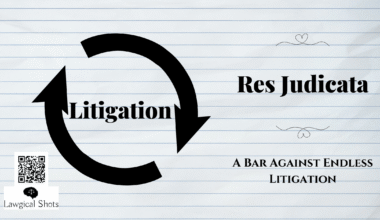Consider a scenario where a person is deliberately walking in the middle of the road and is hit by a speeding motorcycle, resulting in injury. Who is responsible for the collision? Or take another example: a person jumps out of a moving bus and is injured by a passing vehicle. Who takes the responsibility? Questions like these fall under the legal principle of Contributory Negligence in Tort.
In such cases, the Court determines whether the injury or death was caused solely by another party’s negligence, or whether both parties contributed to the incident. There are generally three possible outcomes:
- The defendant’s negligence is solely responsible for the death or injury;
- The deceased or plaintiff’s negligence is solely responsible for death or injury;
- The negligence of both parties caused the death or injury.
The plaintiff will succeed if the defendant’s sole negligence caused death or injury, although there was some negligence on the part of the plaintiff. If the plaintiff’s own negligence caused death or injury, then the plaintiff will be solely responsible for that, even if the defendant has acted negligently.
Explore How Volenti Non fit Injuria decides responsibility
Determining Contributory Negligence
The Court, while determining contributory negligence, takes into account reasonableness on the plaintiff’s side. As to whether or not the plaintiff has taken good care or protection to avoid the situation.
Elements of Contributory Negligence in Tort
- Failure to exercise reasonable care: Plaintiff did not take reasonable care for their own safety, which means they acted in a way a reasonable person would not have in that situation.
- Casual connection: Plaintiff’s failure to act reasonably for their own safety would have a direct connection with the injuries sustained by the plaintiff.
Case Laws on Contributory Negligence
Sumitra Mitra v. Madhya Pradesh State Road Transport Corporation (1973)
In this case,thePlaintiff was injured while travelling in a bus with her elbow resting on the windowsill. The Court rejected the defendant’s argument of contributory negligence and granted compensation. It reasoned that while travelling on a bus, it was reasonable for passengers to rest their hands on the windowsill, and thus, the plaintiff was entitled to compensation.
Butterfield v. Forrester (1809)
In this case, the plaintiff was riding a horse and collided with a pole erected by the defendant for some repair work on the house. The court ruled out the plaintiff’s suit, holding that the plaintiff’s own negligence was the cause of the injury sustained by the plaintiff, citing a reason that the pole was clearly visible from a distance, and the plaintiff should not behave negligently, overlooking his own safety concern.
Last Opportunity Rule
In cases of contributory negligence, the doctrine of last opportunity(or last clear chance) holds that the party who had the final opportunity to avoid the accident but failed to do so will be held liable for the resulting loss. If the defendant had a clear and final opportunity to prevent the harm after the plaintiff’s initial negligence, the defendant may still be held responsible for the damages, despite the plaintiff’s carelessness. Conversely, if the defendant’s negligence contributed to the accident, but the plaintiff could have avoided the harm by exercising reasonable care, the defendant may not be held liable for the resulting loss.
Davies v. Mann
Plaintiff left his donkey with two of its legs tied in the narrow street. A defendant was coming on his wagon at a very good speed ran over the donkey, and the donkey died. The court stated that while giving the verdict, the defendant would have the last opportunity to avoid the accident by taking ordinary care.
Difference between Act of God and Inevitable Accident Explained
Doctrine of Apportionment
According to this doctrine, damages in case of contributory negligence shall be distributed proportionately depending on the contribution of the parties. This is mostly useful in deciding compensation in road accident cases.
Vidya Devi v. M.P. State Road Transport Corporation (1974)
A motorcycle ran into a bus negligently and killed. The bus driver was also found negligent for failing to prevent the possible collision. The Court found that the deceased motorcyclist was more careless than the bus driver. The blame was in a two-thirds (motorcyclist) and one-third (bus driver) ratio.
Maya Mukherjee v. Orissa Co-op. Insurance Society Ltd (1976)
A motorcyclist and a car collided which resulting in the death of the motorcyclist. The court awarded the damages in a 60:40. 60% of damages were borne by the motorcyclist because of his negligence, and 40% of damages were borne by the car driver.
Doctrine of Alternative Danger
The doctrine of alternative danger states that there may be some instances where, to avoid any danger or negligence caused by the defendant, the plaintiff has to take some risk, which may result in loss or injury to the plaintiff. During those instances court cannot rule out the negligence caused by the defendant, and in defence of oneself plaintiff suffered injury or damage.
If the plaintiff’s chosen course of action may lead to harm to themselves, their claim against the defendant remains valid, provided their decision was reasonable under the circumstances.
Shyam Sunder v. State of Rajasthan
The defendant’s negligence resulted in the truck catching fire as soon as the journey started. To avoid the situation, the plaintiff jumped out of the truck but tragically died after colliding with a stone. The defendant was held liable for the consequences of their negligence.
Conclusion
The Contributory Negligence in the law of tort provide a safeguard to the defendant in case of the accident caused by the plaintiff’s negligence. It emphasised that the damage caused or bearing of those damages would be proportionately distributed between both parties based on the negligence or contribution of each party to the accident. If the plaintiff failed to take reasonable care to protect themselves, which may lead to injury or losses, this can serve as a defence for the defendant, subsequently barring or reducing the plaintiff’s ability to recover damages from the negligent party. The principle aims to hold individuals accountable for their own actions and uphold the duty of self-care.
The concept of contributory negligence in Tort is beautifully explained by our intern, Ms Neha Patidar. She has been assisting the team in bringing informational legal blogs.








